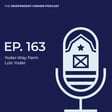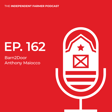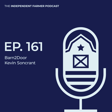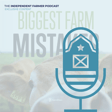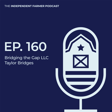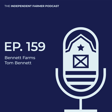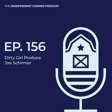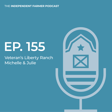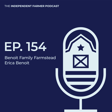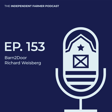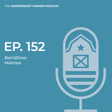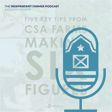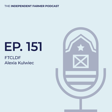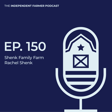Become a Creator today!Start creating today - Share your story with the world!
Start for free
00:00:00
00:00:01

Exclusive Content: 5 Steps to Your Farm’s First $100K
Learning how to create a strategy to market your business, build a base of buyers, and how to hone in on go-to-market efforts, are key steps to help your Farm exceed your revenue goals.
In this week's episode, we are reading a popular Barn2Door eBook – 5 Steps to Your Farm’s First $100K.
Download the eBook Today!
For more resources, including eBooks, visit barn2door.com/resources
Transcript
Introduction to Direct Farm Podcast
00:00:03
Speaker
Welcome to the Direct Farm podcast, the go-to resource for farms across the US looking to grow and manage their business. Tune in weekly to hear tips and tactics from our most successful farmers on how to increase sales, access more customers, and save time and money. We'll also speak with industry experts, business leaders, and partners to share the latest farm business trends selling direct to market.
00:00:27
Speaker
Hello, everyone. This is Natalie with Barn to Door. Welcome to our Direct Farm podcast. Today, I'm going to be reading Five Steps to Your Farm's First 100K.
00:00:41
Speaker
Alrighty, let's go ahead and begin.
Planning and Organizing Your Farm Business
00:00:44
Speaker
Building any business requires many moving parts, some fun, like choosing your name, and others not so fun, like filing taxes. Both require planning, execution, and organization. However, to build a thriving farm business, processes need to be put in place to attract loyal buyers and make smart financial decisions to secure the future of your business.
00:01:06
Speaker
With millions of farms across America, building a farm business requires a lot of work. While specific operations vary significantly from one farm to the next, every farmer ultimately needs to set their sights on a goal to turn a profit to make their business viable long term.
00:01:23
Speaker
capitalizing on the successes of farmers who started their business with Barnador. This ebook summarizes the key tactics to building a thriving direct-to-market farm business to help you earn your first $100,000. Farmers will learn how to create a strategy to market your business, create a reliable network of buyers, set goals, and focus go-to-market efforts to achieve and exceed your revenue goals.
Building a Strong Farm Brand
00:01:50
Speaker
Step one, build your farm brand.
00:01:54
Speaker
Now more than ever, customers' connection to your farm brand is essential to your success. In fact, 64% of Americans form brand loyalty to businesses because of shared values. On the surface level, from your name to your colors, your farm needs to deliver a consistent brand experience across all channels to achieve recognizability. While this is a fun design aspect, your messaging must also be consistent no matter where someone comes in contact with your farm business. What does brand messaging include?
00:02:24
Speaker
Who are you, why you farm, and what products you offer customers. Being accessible on all channels, web, mobile, social, and email is essential to build brand awareness.
Expressing Your Farm's Unique Value
00:02:37
Speaker
Did you know that on average, it takes five to seven impressions for people to remember your farm brand? That's why the more you interact and engage customers, the more they remember your brand, thus creating stronger relationships. When building your farm brand, ask yourself the three W's.
00:02:54
Speaker
The first place to start is to share your story. Why do you farm? Why is your farm unique? Why should people buy from you? Most brands have difficulty explaining why they are in business. The why encompasses what makes you passionate about farming and how you uniquely serve your customers. You'll need to be consistent, honest, and use evidence to support your claims as much as possible. Showcase your certifications, affiliations, and farming practices.
00:03:23
Speaker
This information is key to instilling trust in your brand, improving reliability. Customers want someone they can rely on, look up to, and feel connected to. Are there three adjectives that capture your why?
00:03:38
Speaker
Grass-fed Cattle Company is a grass-fed, pastured protein operation in Minnesota.
Enhancing Farm Discoverability
00:03:43
Speaker
Valerie and Jared have done an excellent job in building brand awareness locally by showcasing their story, why they're passionate about farming, and what makes their products unique, displayed on their websites about Page. Their farming values shine through their messaging.
00:03:58
Speaker
Our mission to provide people with 100% grass-fed beef and pastured pork that customers could connect with, knowing what farm it was raised on, connecting with who raised it, and understanding how it was raised. Valerie carries their core values across their social media and email newsletters, keeping their brand experience consistent no matter where someone comes in contact with their farm.
00:04:21
Speaker
Next, determine where your farm should be discoverable. Remember, when your farm is findable, either Google search, social media, or at a farmer's market, you'll likely attract a larger, loyal customer base when customers can find your farm branded
Engaging Customers with the Three E's
00:04:38
Speaker
website. That's mobile compatible, social media, like Facebook and Instagram, and email. They're more likely to buy from your farm since they'll be familiar with your business and brand.
00:04:50
Speaker
Last year, 65% of online sales occurred through mobile and social media, while the remaining 35% occurred through desktop and email. Your business will be forgotten if your farm isn't consistently engaging customers on all channels.
00:05:07
Speaker
An excellent example is Dirty Girl Produce. Dirty Girl Produce is a certified organic produce farm in Northern California. When a potential customer looks between their Facebook page or Instagram feed, they can recognize the Dirty Girl Produce brand through consistent imagery and messaging. Note that the About section on both social platforms links directly to Dirty Girl Produce's online store, making it easy to add items to cart and check out.
00:05:34
Speaker
As Dirty Girl Produce has become a staple at farmers markets in the Bay Area, they've grown a large, loyal customer base that has been built on a trustworthy brand that is visible across all channels. And finally, the what.
00:05:48
Speaker
You've determined the why and you know where to share the information. Now you need to decide what content to use to promote your business. Another simple acronym to remember are the three E's, entertain, educate, and e-commerce. By sharing a range of content with your followers and buyers across social media, email, and your website, buyers are more likely to engage with your business as they learn more about your
Building Customer Loyalty Through Branding
00:06:14
Speaker
farm. You can educate your customers about your farming practices and products,
00:06:18
Speaker
entertain followers through a funny story or relatable moment, and promote your online store by sharing what's new for the season and how to shop from your farm store. An example would be from Chucktown Acres. They are a regenerative protein farm located outside of Charleston, South Carolina. Understanding the importance of diversified social media content, Farmer Alex takes advantage of the three E's on social media to share with his followers and customers.
00:06:44
Speaker
He posts educational information on farming, shares entertaining videos of himself, and posts pictures of what's included in their weekly CSA box to prompt customers to purchase. His tactics work so consistently that it has led to skyrocketing subscription sales, where they even had to close subscription signups because they received too many orders.
00:07:06
Speaker
In a global survey, 60% of shoppers said that they actively buy from brands they know, whereas 21% said that they purchased a product because they liked the brand. Local customers want to build a relationship with your farm business and feel a connection to your story. Your brand is what will leave an impression on your customers after the sale. Good branding makes your farm memorable, providing the power to create a strong network of loyal customers.
Identifying and Targeting Ideal Customers
00:07:34
Speaker
Step two, define your customer base. You understand your brand, but now you need to define your ideal customers. It is not possible to please everyone. If you attempt to cast such a wide net, you'll actually diminish the value of your brand. Rather, define your target audience and who you are speaking to when engaging ideal customers online.
00:07:56
Speaker
Instead of looking for 100,000 people to spend $1 with your farm, you are much better off targeting a reliable group of 200 customers who are willing to spend $500 purchasing your farm products over the course of a season. It is more cost effective and less work to build a base of recurring buyers. And this will be your ticket to success.
00:08:18
Speaker
Your target audience refers to the group of people that will most likely be interested in your products. To find them, you will need to determine some important information, including their demographics, like location, age, gender, employment, and income, their interests, and buying behavior. Are you targeting soccer moms, older families, or young millennials committed to buying local food?
00:08:42
Speaker
Whoever they are, don't overwhelm yourself with targeting too many buyers. The most successful farmers focus on three or four different buyers.
00:08:51
Speaker
Next, focus on the geographical area you wish to serve. Is it a nearby metropolitan city, sleepy suburb, or rural area with a handful of residents? Depending on your farm's location and distance from your target market, decide if you need to focus on one or multiple markets to grow your business. You need to identify how you will serve your target buyers as well, local pickup or direct delivery. This helps farmers narrow down zip codes and locations.
00:09:19
Speaker
Note that we encourage beginning farmers to refrain from shipping initially given the number of variables and high loss rates. Why is defining your target audience so important? Because by narrowing your focus to specific groups of buyers who are likely to engage with your farm, it will be much easier to solidify a brand voice, messaging, and how to communicate your value proposition.
Gathering Audience Insights
00:09:44
Speaker
For example,
00:09:45
Speaker
If you want to appeal to suburban families, focus on specific activities, foods, packaging, and recipes that cater to that audience. When you know who you're talking to on social media, in your emails, or your website, you can share information that truly resonates with them, making it easier to connect and earn customer loyalty. Here are four steps to find more information about your target audience.
00:10:12
Speaker
Look at social media insights. To understand who follows your social channel, use Facebook Insights and Instagram Analytics. These are two tools to check regularly where you can gain information about your followers interests and discover which posts and pictures will resonate with them the most. Then, use Google Analytics. If you currently have a farm website, Google Analytics will tell you your audience's demographics and interests. This can help you identify who is interested in your products.
00:10:42
Speaker
Use the U.S. Census. Research available free data from the census to better understand where your target buyers live, helping to inform your go-to-market efforts.
00:10:52
Speaker
Then survey current customers. Your current customers can give you a lot of information on who you should target. Ask questions like, how many people do you live with? What zip code or city do you reside in? How far are you willing to drive for farm pickup? Or would you like a direct delivery service? This can help you make more informed decisions on which demographic you should target.
00:11:15
Speaker
Once you have defined your audience and target geographies to serve, then pick where you should be present to serve customers, all the way down to the specific zip code. The sooner you can find opportunities that drive awareness about your farm, the more quickly you'll be on your way to your first $100,000.
Adapting to Online Shopping Trends
00:11:33
Speaker
Step three, understand buyer's expectations.
00:11:39
Speaker
The shift to online shopping has caused buyers' expectations to soar. Billion-dollar brands like Amazon, Cabela's, and Target have changed the way buyers shop today, anywhere, anytime, online. More than 60% of small businesses in America have a website, and an average of 33% of Americans use the internet to search for local businesses every day.
00:12:01
Speaker
With only 1% of Americans actively attending farmers markets, it is very important to find multiple avenues to help you establish your farm brand in your local community and access more buyers. Through the convenience of purchasing online, many Americans are foregoing traditional shopping experiences to purchase what they need from the comfort of their own couch. A simple point and click shopping experience from your farm will be essential to reaching more local customers and driving sales.
00:12:30
Speaker
Buyers have specific expectations when shopping online, whether it's local retail buyers, CSA or subscription members, or wholesale customers. Each wants to access your farm store anywhere, anytime, and on any channel. That's web, mobile, social, and email.
Creating Seamless Purchase Experiences
00:12:47
Speaker
Even if you have every channel covered, many customers don't want to exchange seven or more emails, texts, or phone calls with you to place an order.
00:12:56
Speaker
no matter how much they like you or your farm products. Rather, you need to meet their expectations of how they're already shopping for other products. Here are three steps your farm can take to meet buyers' expectations.
00:13:12
Speaker
Offer a point and click purchase experience. Instead of spending hours manually managing orders over the phone, email, and text messaging, streamline how buyers purchase from your farm. Push all buyers to shop online from your farm store, which will drastically reduce the effort to close sales.
00:13:31
Speaker
Create a consistent pickup schedule. Whether on the farm or at the convenience locations in town, create consistent and routine pickup options. Buyers should be able to add the pickup date to their calendar without coordinating a date and time. Note that if you offer on-farm pickup, you should be within 15 miles of the nearest town.
00:13:53
Speaker
Offer direct delivery. One in three Americans have ordered food online with the expectation of it appearing on their doorstep. Charge a delivery fee, eight to $10, and start with one to two zip codes, narrowing your delivery days to one to two times per month.
00:14:11
Speaker
The farmers market is also a great place to meet buyers expectations for ordering anytime, anywhere, online. There are key steps you should be taking to convert market attendees to loyal online buyers. First, gather emails. Farmers have seen 80% of their weekly orders come through a single email.
00:14:31
Speaker
That's why you should gather customer email addresses. Have an email sign up sheet and use a QR code for a quick and easy way to grow your farm's contact list. Offer a promo for their first online purchase. Next, pass out farm flyers. QR codes are a gateway to sending customers to the desired webpage. Have a QR code for your email sign up to your online store and social handles on a handy farm flyer to pass out at the markets or include in order boxes. And finally, be present in the community.
00:15:01
Speaker
If you want to sell to the local community, you need to be visible among the people who live there. Partner with local businesses, schools, places of worship, or community centers to get your products into local hands and inform community members about your farming practices.
00:15:17
Speaker
For your farm to be successful, you must meet the current shopping expectations of your buyers.
Pricing and Packaging Strategies
00:15:23
Speaker
Allowing customers to purchase from your farm online will be the first step in offering them the convenient experience they expect. Convenient delivery and pickup provides customers with various choices to fit their busy schedules. These services can be built surrounding your schedule, providing enough space for customers to find a service that works for them.
00:15:44
Speaker
Step four, price and packaging products for success. The pricing and packaging of your farm products are essential to the success of your business and your first 100K. Price defines the value of your product and how much your customers are willing to pay. On the other hand, your packaging has the power to differentiate your brand from others, where customers can develop feelings about how they perceive the quality of your offering.
00:16:10
Speaker
When it comes to price, there are a handful of variables to determine the right price for your products. A good place to start is to identify how much each product costs to produce. Don't try to compete with a local grocery store commodity product. Your products are premium, so price them as such.
00:16:27
Speaker
Locally produced food is valuable, and the higher the price, the higher the perceived value. Charging a premium for your products actually creates a confidence and trust in your brand and will lead to an increase in demand. We promise we see it happen every day. When you charge a comparable price to low-end products in the grocery store, the perception of the quality of your products and farm brand are greatly diminished.
00:16:53
Speaker
when it comes to packaging. Packaging is a tangible reflection of your brand. That's why it needs to reflect your values by being fully recyclable or including your logo and colors for easy identification. Packaging can truly be a make it or break it moment when customers are first interacting with your brand. In fact, 13% of customers are willing to pay up to 50% more for products that they view as positively impacting the world. That is huge.
00:17:23
Speaker
Here are the three steps to price and package your products for success. First, offer bundle boxes. Bundling items gives buyers access to more products in a single purchase. Plus, you move more products in one box. Provide specialty or highly desired items only in bundle box formats to move more inventory items. Evolve your bundles with the seasons and specific holidays to increase conversions.
00:17:49
Speaker
Second, create subscriptions. Subscriptions are your farm's secret weapon to locking in buyer commitments and securing consistent revenue for your farm. As Americans have on average, nine plus paid subscriptions. The option of a food subscription is highly desirable. We need to eat every day and knowing that fresh farm products will show up regularly is a weight off of many American's shoulders.
00:18:15
Speaker
And third, cater to all household sizes. Your farm must be able to cater to a range of buyer needs. As one third of Americans live alone, one third live in a household of two to three people, and the remaining third live with four or more people. Packaging products to meet these criteria will be the key to driving more orders from your farm. Create three variations to reflect different household sizes of both bundle box and subscription options.
00:18:44
Speaker
More than 80% of customers will pay more for a product to support local businesses. Your price, packaging, and branding go hand in hand with creating the experience of shopping from your farm. Your packaging is a reflection of your brand and values. Don't be afraid to charge a higher price to turn a profit. Your livelihood is just as important.
00:19:05
Speaker
And
Setting SMART Goals for Growth
00:19:06
Speaker
finally, step five, set goals and measure them often. As a business owner, your priorities should be setting goals, identifying buyer's needs, uncovering weak points, and identifying growth opportunities. Gathering and analyzing real-time data based on your farm's operations can help you proactively keep up with the demand of your products and meet your business goals. If your goal is 100K,
00:19:32
Speaker
you need to measure the success of your farm consistently to stay on the right track. Checking in on your progress weekly, monthly, and quarterly will help you uncover what's working and where there are opportunities for growth to achieve your annual goal. Proactively tracking your goals will make it easier to grow your business and scale your operations. A good way to create goals is to set SMART goals. SMART stands for specific, measurable, attainable, relevant, and time-bound.
00:20:02
Speaker
While the overarching goal is 100K, narrow your goal to something smaller to be more aligned with smart. For example, if you want to drive 15% of your sales from email, you need to be specific and identify the steps to get you there. Maybe it's sending weekly order reminders, reengaging customers that didn't purchase last month, or acquiring 25 new email signatures at the market on a given day.
00:20:32
Speaker
To measure the goal, you'll want to track how your emails perform, track open rates, click rates, and how many orders you received. To make the goal attainable, make sure everyone on your team is aware of the goal so they can help you achieve it. The goal is relevant because it will help your business grow, contributing to your farm's overall revenue.
00:20:54
Speaker
Lastly, to make it time-based, give yourself a deadline. Are you trying to grow 10% of your sales every month or every quarter?
00:21:04
Speaker
Using smart goals allows you to identify and track how well you achieve your goal. However, you need the proper tools to actively measure if you are meeting your goals. Keep track of your finances. Keeping your books up to date by using tools like QuickBooks Online to track sales data and Avalara to manage complex tax codes is essential to the overall financial health of your business.
00:21:27
Speaker
Gaining visibility into the workings of your operations and how you can optimize activities is crucial to building a successful farm business. You must remain flexible to allow yourself to change course as nothing is set in stone. When you see what's working and what's not, you can change the areas of your operations that aren't contributing to your success. Tracking your progress consistently and using the right tools to help you will make achieving your first 100K easier and more attainable.
00:21:57
Speaker
At its core, your farm business is a combination of your products, values, and brand experience. To attain your first 100K, spend the time to develop key areas of your business that will have the most significant impact on outcomes. When buyers trust your brand, you'll create a reliable customer base that will make it easier to grow your business.
Podcast Wrap-up and Resources
00:22:19
Speaker
Thank you so much for joining me today as we read five steps to your farm's first 100 K. See you next time on the direct farm podcast. Thanks for tuning in for more free farm resources, tips, and tactics that are most successful farms use to grow and manage their business. Visit barnadore.com slash resources. Also don't forget to subscribe to the direct farm podcast to automatically download our weekly episodes. Thanks for listening and we'll see you next week.

